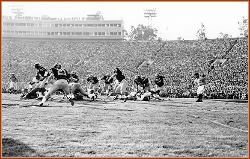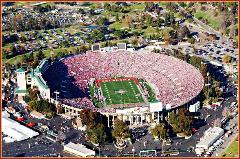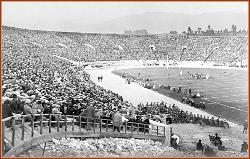



History
In the fall of 1904, Edwin Jackson Kyle '99, then professor of horticulture, was named
President of the General Athletics Association. Kyle wanted to secure and develop an
athletic field to promote the College's athletics, so he fenced off a section of the
southeast corner of campus, which was assigned to him for agricultural use. In March of
1904, a fence was built, and in October of 1904, the covered grandstand from the Bryan
fairgrounds was purchased, and wooden bleachers were built, raising the seating
capacity to 500 people. Since the College did not provide Kyle any funds, he covered all
of the costs (over $650) himself. On November 10, 1904, the College Board of Directors
set this area as a permanent athletic field. At this time, the field was the home for the
football and baseball teams. After the stands were built, student support at a yell practice
and a meeting in the chapel led to the field being named after it's founder and builder.
There has been some confusion over the name; some believe that it was named after Dr.
J. Allen Kyle, a member of the Board of Directors from 1911-1915, but the Board of
Directors has decreed that Kyle Field was in fact named for E.J. Kyle '99. In 1919, the
first annual Thanksgiving game between the A&M College and the University of Texas
was played, which was also the first game to be play-by-play broadcast over the
radio.[citation needed] After the first World War, the stadium was dedicated as a living
memorial to the Aggies who died in the war. On game days 55 American flags, one for
each Aggie killed, fly around the highest points of the stadium.




The 12th Man
In Dallas on January 2, 1922, at the Dixie Classic (the forerunner of the Cotton Bowl)
A&M played defending national champion Centre College in the first post-season game
in the southwest. In this hard fought game, which produced national publicity, an
underdog Aggie team was slowly but surely defeating a team which boasted having
three All-Americans. Unfortunately, the first half produced so many injuries for A&M that
Coach D. X. Bible feared he wouldn’t have enough men to finish the game. At that
moment, he called into the Aggie section of the stands for E. King Gill, a reserve who
had left football after the regular season to play basketball. Gill, who was spotting
players and was not in football uniform, willingly volunteered and donned the uniform of
injured player Heine Weir. Although he did not actually play in the game, his readiness
to play symbolized the willingness of all Aggies to support their team to the point of
actually entering the game. A&M finally won 22-14. When the game ended, E. King Gill
was the only man left standing on the sidelines for the Aggies. Gill later said, "I wish I
could say that I went in and ran for the winning touchdown, but I did not. I simply stood
by in case my team needed me." A statue of E. King Gill stands to the north of Kyle Field
to remind today’s Aggies of their constant obligation to preserve the spirit of the Twelfth
Man. That spirit of readiness, desire, and enthusiasm has continued through the years,
and to this day the Aggie student body, known as the Twelfth Man, remains standing at
football games as a gesture of its loyalty and readiness for duty. But the tradition of the
Twelfth Man embraces more than mere athletic events. It is the essence of the Aggie
Spirit that unites all Aggies into a fellowship of service and devotion to each other and
their school.
In the 1980s, Jackie Sherrill created the "12th Man Kickoff Team" composed of regular
students who tried out for the team instead of players who were recruited, as is the
normal practice in college football. These students were placed on the roster for the sole
purpose of running the kickoffs. This 12th Man team performed very well and held
opponents to one of the lowest yards per return averages in the league. Later, Head
Coach R.C. Slocum changed the team to allow only one representative of the 12th Man
on the kick off team who wears uniform number 12. However under Dennis Franchione
the "12th Man Kickoff Team", entirely made up of walk-ons, has been brought back
though used only rarely.
The 12th Man has evolved into a tradition at Texas A&M. The Texas A&M student body
acts as the "12th Man" for the football team and stands throughout the entire game,
ready to help the team should the need arise.










